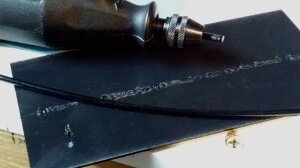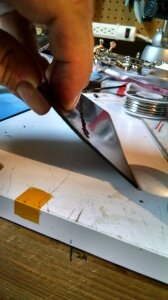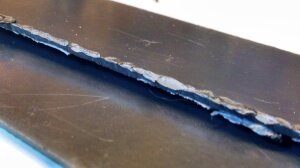Hack-a-day had an article a short while ago about welding ABS parts together with a short length of ABS filament in the chuck of a dremel tool. The idea is to use the friction from the fast spinning filament to melt the plastic at the junction of the spinning filament and parts. You can find the article here. This reminded me of a toy plastic welding kit that a friend had given my kids. This set uses a battery operated drill-like unit that takes special formed sticks as the sacrificial weld material. You would use it to weld together the plastic parts in the kit to form models.
I decided to try it out with some scrap flat ABS plastic and a length of ABS filament. I did as the article suggested, snipped off a small length and put it in the chuck of the dremel. As in the article, I used a short length of filament. The curvature of it keeps it from being straight in any length, so shorter is easier to keep from flapping about as it spins. Having experience with the styrene welding kit, I knew that you would need to finesse it and figure out the melting point of both the filament and the plastic being welded. I tried several techniques, but for a flat plate butt joint, the best was having the filament perpendicular to the plates being welded.
I was able to produce straight on tack welds with ease. It was working down the seam that was challenging.
As you can see, the joined pieces can flex a fair bit without breaking the joint. This picture was after quite a bit of welding was done down the seam. Early in the process, I was surprised that I didn’t need that many tack welds on both sides to get the two plates acting as one and not cracking apart with slight flexing.
Typically when you’re testing any method of joining materials, you will want to do a tear down test. It took a bit of effort to crack it in half and tear it apart. In the picture above, it can be seen that the weld nuggets tore out, leaving a divot in the plastic where the nugget was. This is a good sign when you’re welding, whether it’s plastic or metal: you always want to see the material tear away from the nugget, rather than the nugget splitting at the seam where it was to join the materials.
My conclusion: if you have a dremel, you can friction weld with filament fairly easily. The welds are strong and can be used to fix broken parts or join prints that couldn’t be printed in one piece. Considering it’s not a huge investment of time to get comfortable with the technique, it’s worth trying out and practising on some failed prints. You’ll get a feel for it, and it will cement it in your head that it’s a viable option other than glue. However, if you’re looking for beautiful welds, this technique won’t produce them!


 January 27th, 2015
January 27th, 2015  bitreaper
bitreaper





 Posted in
Posted in